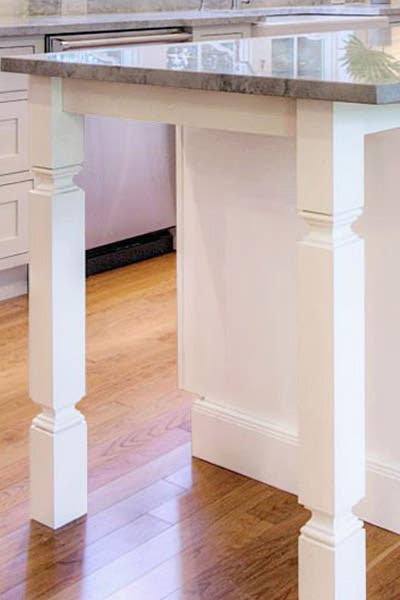Check Out Timeless Options in Standard Legs For Kitchen Island Layouts
Wiki Article
Important Factors to Consider When Picking Legs For Cooking Area Island
Selecting the proper legs for a kitchen island includes a mindful evaluation of numerous factors that can substantially influence both performance and visual appeal. As we check out these components, it ends up being clear that each choice can have far-reaching ramifications for the total kitchen experience.Material Options
When picking legs for a kitchen island, comprehending the numerous material choices is crucial for achieving both aesthetic allure and architectural integrity (Legs For Kitchen Island). The option of product dramatically influences not only the toughness of the island yet also its overall style and performanceTimber is a preferred choice, providing warmth and adaptability. Strong woods, such as oak or maple, offer toughness and can be discolored or painted to match the kitchen style. Metal legs, typically made from stainless-steel or wrought iron, add a contemporary and industrial feeling while making certain sturdiness and security. These materials are resistant to wear and can support substantial weight, making them optimal for bigger islands.
An additional alternative is engineered materials, like MDF or plywood, which can be more cost-effective while still supplying a series of coatings. Nevertheless, they may not provide the very same degree of stability as strong timber or metal. Materials such as acrylic or glass can develop a contemporary look, though they might require added support to ensure security.
Eventually, the option of product for kitchen island legs need to line up with the desired capability and the overall motif of the kitchen area.
Design And Style

When thinking about design, the shape and finish of the legs are essential. Tapered legs can provide a sense of agility and elegance, while thicker, more robust legs can convey strength and stability. In addition, the coating-- be it repainted, tarnished, or all-natural-- must match the cabinets and counter top materials to create a unified appearance.
In addition, the layout of the legs can likewise show personal preference. Personalized or attractive legs, such as those including elaborate carvings or unique geometric forms, can offer as focal points, adding personality and character to the kitchen area. Ultimately, the right selection will not only boost performance but additionally boost the aesthetic allure, making the cooking area island a standout function of the home.
Elevation Factors To Consider
Selecting the appropriate elevation for kitchen island legs is crucial, as it straight affects both capability and convenience. The basic elevation for a kitchen area island generally varies from 36 to 42 inches, lining up with usual counter top elevations. A 36-inch height is ideal for food prep work and cooking, permitting for comfortable usage of kitchen devices and tools. Alternatively, a height of 42 inches is often liked for islands intended for bar seating, suiting taller stools and supplying a casual eating experience.:max_bytes(150000):strip_icc()/pink-marble-tile_House-of-Harvee-9f030193ae38484a9cb7ea2d71af66f4.jpg)
It is additionally necessary to represent individuals' preferences and elevations. Personalizing the height can make certain a comfy experience for a knockout post all member of the family, making the kitchen island an extra useful and pleasurable space.
Weight Assistance
Ensuring ample weight support for cooking area island legs is important for both safety and performance. The kitchen island commonly serves numerous purposes, consisting of food preparation, dining, and added storage, demanding a robust support framework. When selecting legs, it is vital to consider the general weight capacity needed based upon the island's intended use and the products that will certainly be put on it.The selection of material for the legs have a peek here plays a considerable duty in their weight-bearing capabilities. Solid timber, steel, and heavy-duty composites usually provide exceptional toughness contrasted to lighter materials. Furthermore, the style of the legs-- whether they are right, tapered, or have a pedestal form-- can influence their capability to disperse weight effectively across the structure.
Constantly get in touch with the manufacturer's requirements pertaining to load limits to make sure that the legs can sustain the desired weight without compromising safety. In summary, picking kitchen area island legs with ample weight assistance is vital for developing a useful and secure cooking room.
Installation and Upkeep
Appropriate installation and upkeep of kitchen island legs are essential for guaranteeing longevity and stability. This often includes securing the legs to the island base utilizing appropriate fasteners, making certain that the legs are level and straightened.Once mounted, regular maintenance is essential to protect the honesty and appearance of the legs - Legs For Kitchen Island. For wooden legs, routine cleaning with a moist towel and application of suitable timber gloss can avoid wetness damages and maintain their surface. Steel legs might require a mild cleansing solution to eliminate oil and crud, followed by a dry towel i thought about this to avoid rust development
Additionally, examine the legs on a regular basis for indicators of wear or damages, such as splits or loosened joints. Tightening screws or bolts as needed can also prolong the lifespan of the legs. By adhering to these installation and maintenance practices, property owners can guarantee that their kitchen area island stays durable and visually appealing for many years to find.
Conclusion

Aesthetic coherence is extremely important in choosing the design and design of legs for a kitchen island, as these components significantly influence the total ambiance of the area. Conical legs can give a sense of lightness and beauty, while thicker, a lot more durable legs can share toughness and security.Picking the ideal elevation for cooking area island legs is essential, as it directly impacts both functionality and comfort. In summary, picking kitchen area island legs with sufficient weight assistance is crucial for creating a safe and functional cooking room.
In final thought, choosing legs for a kitchen area island requires careful consideration of numerous variables, consisting of material choices, style, elevation, weight assistance, and setup.
Report this wiki page